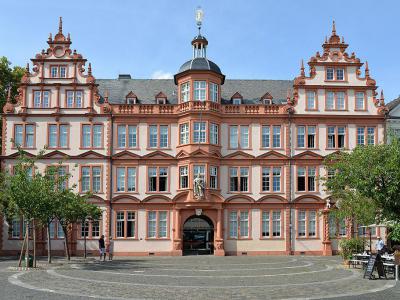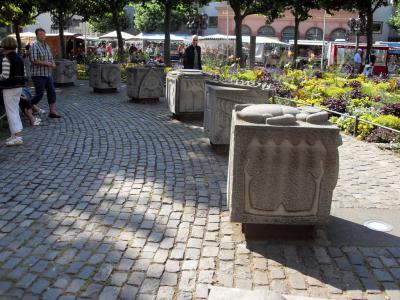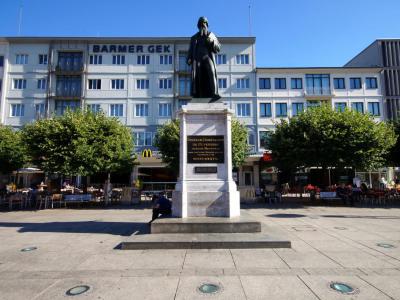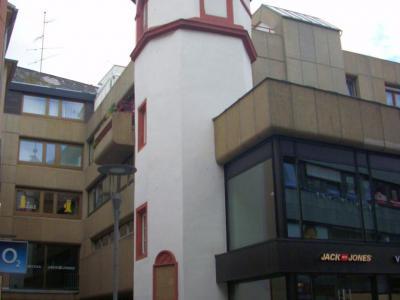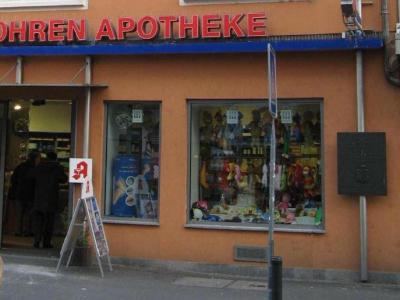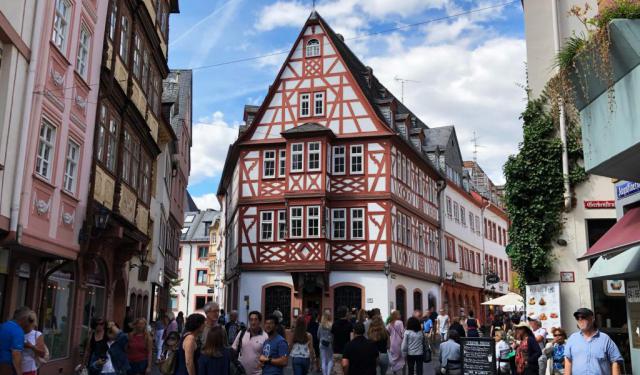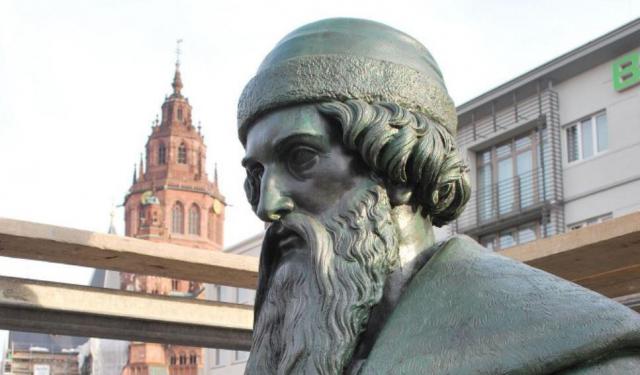
In the Footsteps of Gutenberg (Self Guided), Mainz
The capital of Rhineland-Palatinate, Mainz has made a name throughout the world as Gutenberg's city, the birthplace of Johannes Gutenberg and his great invention, the first movable metal-type printing press. It is precisely for this important heritage that Mainz has retained its importance as a hub for some of Germany's oldest publishing houses.
Following in the footsteps of Gutenberg in his hometown you can start at Gutenberg Museum which outlines the history of Gutenberg's ground-breaking piece of engineering as well as displays some priceless copies of famous publications, like the original 42-line Gutenberg Bible, printed around 1450, and more. Right next to the museum is the Type Monument – a complex of nine sandstone cubes illustrating the art of scripture and printing.
Further on, the itinerary brings you to Gutenbergplatz. This square, Mainz's largest, houses a monument of Gutenberg, unveiled in 1837. The bronze sculpture marks the probable 400th anniversary of the invention of the printing press.
The tour continues to take you along Marktplatz/Korbgässchen to the end of the Am Brand passage where you find the stair tower of Humbrechthof, also known as Hof zum Humbrecht. This building, constructed in 1584, is where the first Gutenberg Bibles were printed.
The final stop on your historical journey through Gutenberg's Mainz will be Hof zum Gutenberg, Gutenberg's Birthplace, situated close-by to his last resting place. Gutenberg was not only born here, but also later set up his first printing workshop; hence, the location is still referred to as "Urdruckerei" (original printing house).
Whether you're just passing through Mainz or staying for a little while and want to explore it on your own, on foot, this self-guided walk will help you get to know the city from the point of view of its great inventor citizen!
Following in the footsteps of Gutenberg in his hometown you can start at Gutenberg Museum which outlines the history of Gutenberg's ground-breaking piece of engineering as well as displays some priceless copies of famous publications, like the original 42-line Gutenberg Bible, printed around 1450, and more. Right next to the museum is the Type Monument – a complex of nine sandstone cubes illustrating the art of scripture and printing.
Further on, the itinerary brings you to Gutenbergplatz. This square, Mainz's largest, houses a monument of Gutenberg, unveiled in 1837. The bronze sculpture marks the probable 400th anniversary of the invention of the printing press.
The tour continues to take you along Marktplatz/Korbgässchen to the end of the Am Brand passage where you find the stair tower of Humbrechthof, also known as Hof zum Humbrecht. This building, constructed in 1584, is where the first Gutenberg Bibles were printed.
The final stop on your historical journey through Gutenberg's Mainz will be Hof zum Gutenberg, Gutenberg's Birthplace, situated close-by to his last resting place. Gutenberg was not only born here, but also later set up his first printing workshop; hence, the location is still referred to as "Urdruckerei" (original printing house).
Whether you're just passing through Mainz or staying for a little while and want to explore it on your own, on foot, this self-guided walk will help you get to know the city from the point of view of its great inventor citizen!
How it works: Download the app "GPSmyCity: Walks in 1K+ Cities" from Apple App Store or Google Play Store to your mobile phone or tablet. The app turns your mobile device into a personal tour guide and its built-in GPS navigation functions guide you from one tour stop to next. The app works offline, so no data plan is needed when traveling abroad.
In the Footsteps of Gutenberg Map
Guide Name: In the Footsteps of Gutenberg
Guide Location: Germany » Mainz (See other walking tours in Mainz)
Guide Type: Self-guided Walking Tour (Sightseeing)
# of Attractions: 5
Tour Duration: 1 Hour(s)
Travel Distance: 1.2 Km or 0.7 Miles
Author: ellen
Sight(s) Featured in This Guide:
Guide Location: Germany » Mainz (See other walking tours in Mainz)
Guide Type: Self-guided Walking Tour (Sightseeing)
# of Attractions: 5
Tour Duration: 1 Hour(s)
Travel Distance: 1.2 Km or 0.7 Miles
Author: ellen
Sight(s) Featured in This Guide:
- Gutenberg Museum
- Type Monument
- Gutenbergplatz (Gutenberg Square)
- Humbrechthof (Humbrecht Court)
- Hof zum Gutenberg (Gutenberg's Birthplace)
1) Gutenberg Museum (must see)
The Gutenberg Museum is dedicated to Johannes Gutenberg, one of Mainz's most famous residents. Gutenberg is known as the "Man of the Millenium" for creating a printing press with movable metal type. Gutenberg's printing press revolutionized the world. The museum also exhibits international printing presses and scripts.
Audio guides are available in English, French, and German, and guided tours are available. Guests can start their visit by watching a short film about Gutenberg's life and work.
The Gutenberg Museum has two priceless copies of the famous original 42-line Gutenberg Bible, printed around 1450. In addition, visitors can see a recreation of Gutenberg's workshop, including a demonstration of how a 15th-century printing press operated.
Additional exhibits include printing presses, typesetting machines, and examples of European book culture from the last 500 years.
Gutenberg Museum houses one of the most impressive bookplate collections in the world. An exhibit displays bookplates from notable figures such as Charles Dickens, Albert Einstein, Charles Lindbergh, and Franklin D. Roosevelt.
The Gutenberg Museum has displays focusing on international printing. One exhibit traces printing in East Asia to the 8th century and another displays Islamic scripts. Additional exhibits show bookbinding, press printing techniques, and paper and color manufacturing.
The museum has exhibits on five floors, including the wonderful gift shop. Visit the education workshop to try your hand at typesetting and printing. Staff members are available to help you get set up.
Audio guides are available in English, French, and German, and guided tours are available. Guests can start their visit by watching a short film about Gutenberg's life and work.
The Gutenberg Museum has two priceless copies of the famous original 42-line Gutenberg Bible, printed around 1450. In addition, visitors can see a recreation of Gutenberg's workshop, including a demonstration of how a 15th-century printing press operated.
Additional exhibits include printing presses, typesetting machines, and examples of European book culture from the last 500 years.
Gutenberg Museum houses one of the most impressive bookplate collections in the world. An exhibit displays bookplates from notable figures such as Charles Dickens, Albert Einstein, Charles Lindbergh, and Franklin D. Roosevelt.
The Gutenberg Museum has displays focusing on international printing. One exhibit traces printing in East Asia to the 8th century and another displays Islamic scripts. Additional exhibits show bookbinding, press printing techniques, and paper and color manufacturing.
The museum has exhibits on five floors, including the wonderful gift shop. Visit the education workshop to try your hand at typesetting and printing. Staff members are available to help you get set up.
2) Type Monument
Situated outside the Gutenberg Museum, the Type Monument is a complex of nine sandstone cubes representing print types. Gutenberg's ground-breaking invention was a press with movable types that allowed text to be put together on the printing block and create a whole page of text at one time. The types were made from small cast lead bars with raised and inverted letters on the end.
The nine cubes feature decorative letters similar to those used in the Gutenberg Bible. On the side facing the cathedral, the cubes spell out the name "Gutenberg." On the opposite side of the sandstones visitors can see, in the chronological order, the development of script – from the Mesopotamian to the modern era.
The monument, offering visitors a wonderful look at the art and science of scripture, was designed by local stonemasons and presented to Mainz as a gift.
The nine cubes feature decorative letters similar to those used in the Gutenberg Bible. On the side facing the cathedral, the cubes spell out the name "Gutenberg." On the opposite side of the sandstones visitors can see, in the chronological order, the development of script – from the Mesopotamian to the modern era.
The monument, offering visitors a wonderful look at the art and science of scripture, was designed by local stonemasons and presented to Mainz as a gift.
3) Gutenbergplatz (Gutenberg Square)
Gutenberg Square was named after Johannes Gutenberg and is Mainz's largest square.
Following occupation by Napoleon's French forces, Mainz became the capital of Mont-Tonnerre in 1801. In 1804, Napoleon ordered the construction of a new boulevard and square. The square was planned in an area that was destroyed during the Austro-Prussian siege. However, only one building was built in the new square before the project failed.
Construction on the square re-started in 1819, and building continued through the 1870s. Many buildings were damaged during World War II and have since been restored.
The Gutenberg monument was unveiled in 1837. The bronze sculpture shows Gutenberg carrying a Bible and a printing plate. There are no reliable images of Gutenberg, so he is depicted as a well-dressed, bearded man. Mainz celebrated for three days when the statue was commemorated.
Gutenberg Square is home to the Mainz State Theatre. The Neoclassical building was completed in 1833 and hosts around 500 dance, opera, and drama events each year.
The 50th parallel north that marks the 50 degrees north of the Earth's equatorial plane runs near the square and is marked with a metal track and bronze lettering.
Following occupation by Napoleon's French forces, Mainz became the capital of Mont-Tonnerre in 1801. In 1804, Napoleon ordered the construction of a new boulevard and square. The square was planned in an area that was destroyed during the Austro-Prussian siege. However, only one building was built in the new square before the project failed.
Construction on the square re-started in 1819, and building continued through the 1870s. Many buildings were damaged during World War II and have since been restored.
The Gutenberg monument was unveiled in 1837. The bronze sculpture shows Gutenberg carrying a Bible and a printing plate. There are no reliable images of Gutenberg, so he is depicted as a well-dressed, bearded man. Mainz celebrated for three days when the statue was commemorated.
Gutenberg Square is home to the Mainz State Theatre. The Neoclassical building was completed in 1833 and hosts around 500 dance, opera, and drama events each year.
The 50th parallel north that marks the 50 degrees north of the Earth's equatorial plane runs near the square and is marked with a metal track and bronze lettering.
4) Humbrechthof (Humbrecht Court)
Humbrecht Court is the building where Gutenberg expanded his printing press and printed the first Gutenberg Bibles. With financial backing from Johann Fust, Gutenberg set up an expanded print shop in Humbrecht Court and printed the famous 42-line Gutenberg Bible in 1450.
The relationship between Fust and Gutenberg turned sour, and Fust sued Gutenberg over a loan. Fust had made a generous loan to fund Gutenberg's print works. The courts ruled that Gutenberg had to turn over half of the printed Bibles to Fust. Gutenberg was financially ruined and moved back to his father's house in 1455, where he set up another printing press.
Fust kept the Humbrecht Court property, renamed it the "Druckhaus" (printing house), and set up a printing press with Gutenberg's former assistant, Peter Schoeffer. Schoeffer married Fust's daughter, and the family kept the printing press going.
Visitors can see Humbrecht Court's 1584 stair tower along with an inscription. Two modern houses have replaced the original building.
The relationship between Fust and Gutenberg turned sour, and Fust sued Gutenberg over a loan. Fust had made a generous loan to fund Gutenberg's print works. The courts ruled that Gutenberg had to turn over half of the printed Bibles to Fust. Gutenberg was financially ruined and moved back to his father's house in 1455, where he set up another printing press.
Fust kept the Humbrecht Court property, renamed it the "Druckhaus" (printing house), and set up a printing press with Gutenberg's former assistant, Peter Schoeffer. Schoeffer married Fust's daughter, and the family kept the printing press going.
Visitors can see Humbrecht Court's 1584 stair tower along with an inscription. Two modern houses have replaced the original building.
5) Hof zum Gutenberg (Gutenberg's Birthplace)
Johannes Gutenberg was born here between 1394 and 1404, although no records indicate the exact day, month, or year. In the 1890s, the city of Mainz declared his symbolic date of birth to be June 24, 1400. Gutenberg didn't spend his entire life in Mainz but spent some time in Strasbourg.
By 1448, he returned to Mainz and set up his first printing press in his father's house. He extended his printing press in 1450 at Humbrecht Court and printed the Gutenberg Bible in 1455.
After a financial disagreement with a business partner, Gutenberg returned to his father's home.
The Hof zum Gutenberg became part of Mainz University in 1477. The building is known as "Urdruckerei," or the original printing house. The building was rebuilt in the Baroque style but destroyed during World War II. Today, the site houses a pharmacy.
By 1448, he returned to Mainz and set up his first printing press in his father's house. He extended his printing press in 1450 at Humbrecht Court and printed the Gutenberg Bible in 1455.
After a financial disagreement with a business partner, Gutenberg returned to his father's home.
The Hof zum Gutenberg became part of Mainz University in 1477. The building is known as "Urdruckerei," or the original printing house. The building was rebuilt in the Baroque style but destroyed during World War II. Today, the site houses a pharmacy.
Walking Tours in Mainz, Germany
Create Your Own Walk in Mainz
Creating your own self-guided walk in Mainz is easy and fun. Choose the city attractions that you want to see and a walk route map will be created just for you. You can even set your hotel as the start point of the walk.
Mainz Introduction Walking Tour
Mainz is the Rhineland-Palatinate state capital and its largest city. It is located on the Rhine river, where the Main river joins the Rhine. Mainz has remained a prosperous city and is an important container port hub.
Mainz was founded as a Roman military fortress in the 1st century BC. The Roman stronghold was called Mogontiacum. Visitors can see several Roman shipwrecks and learn more about... view more
Tour Duration: 2 Hour(s)
Travel Distance: 3.3 Km or 2.1 Miles
Mainz was founded as a Roman military fortress in the 1st century BC. The Roman stronghold was called Mogontiacum. Visitors can see several Roman shipwrecks and learn more about... view more
Tour Duration: 2 Hour(s)
Travel Distance: 3.3 Km or 2.1 Miles
The Most Popular Cities
/ view all
